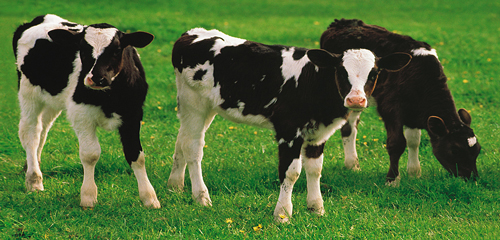
Switching the source of fibre in a calf starter ration has prompted an increase in daily liveweight gain of around 10 per cent in young calves, a new study has found.
The study, carried out at Emma and Joff Roberts’ Uphampton Farm at Shobdon near Leominster, took two batches of evenly-matched two-week old calves past weaning over a nine-week period. One batch was offered the usual calf starter nut alongside milk, with the other offered the same nut but with most of the soya hull content replaced by nutritionally improved straw (NIS).
The calves fed the standard ration gained an average of 0.99kg per day over the nine-week period, whereas the calves fed the NIS ration gained 1.1 kg per day. The cost per kg of each calf starter was the same, but the calves on the NIS ration ate 3.5% more – 152 kg each compared with 146.8kg.
Emma, who rears around 700 calves each year, taking them from two to twelve weeks of age, believes the difference lies in the effectiveness of the fibre source in kick-starting rumen function and avoiding the post-weaning ‘slump’.
“The calves were noticeably thriving on the adjusted ration; aside from the liveweight gain, I recorded 190 incidences of dirty tails throughout the period in the group fed the control ration, compared with 113 in the group fed the NIS diet.
“We’re repeating the study to get a better idea of the average gain we can expect but we’re confident there’s a positive effect. Even our vet has commented on the bloom on the calves fed the NIS-based diet.”
Wynnstay’s feeds product manager Steve Brown, who set up the study, says using a more digestible form of fibre in the NIS-based ration improved rumen development.
“We’re really encouraged by these early results,” he says. “From three days old, the aim should be to offer a solid feed the calf likes but which also gets the rumen wall working so the calf can start chewing cud. This then allows the optimum level of starch to be included in the diet to develop the rumen papillae.
“Fibre should ideally be chopped or long straw so that saliva can buffer these acidic rumen contents. However, calves can’t eat enough fibre in this form so, instead, fibre has to be added to the compound feed. This has typically been in the form of soya hulls, but the theory is this is indigestible seed coat rather than stem fibre and can pass through the animal before having the chance to stimulate the rumen sufficiently.”
Steve says the rerun of the study will this time include NIS at a slightly higher level and will also monitor the calves longer – for 12 weeks – to get a better idea of what happens in the post-weaning phase.
“In the meantime, we’re sufficiently convinced of the benefits of NIS that we have included NIS in our mainline calf starter diet, Start ‘n’ Wean, and have also introduced two new beef and lamb finishing diets including NIS where the same rumen health benefits will be seen.”
